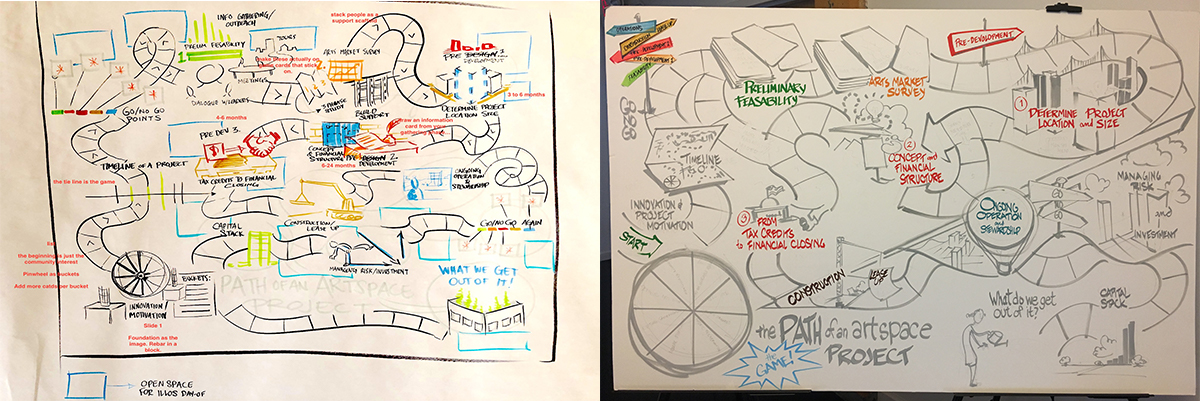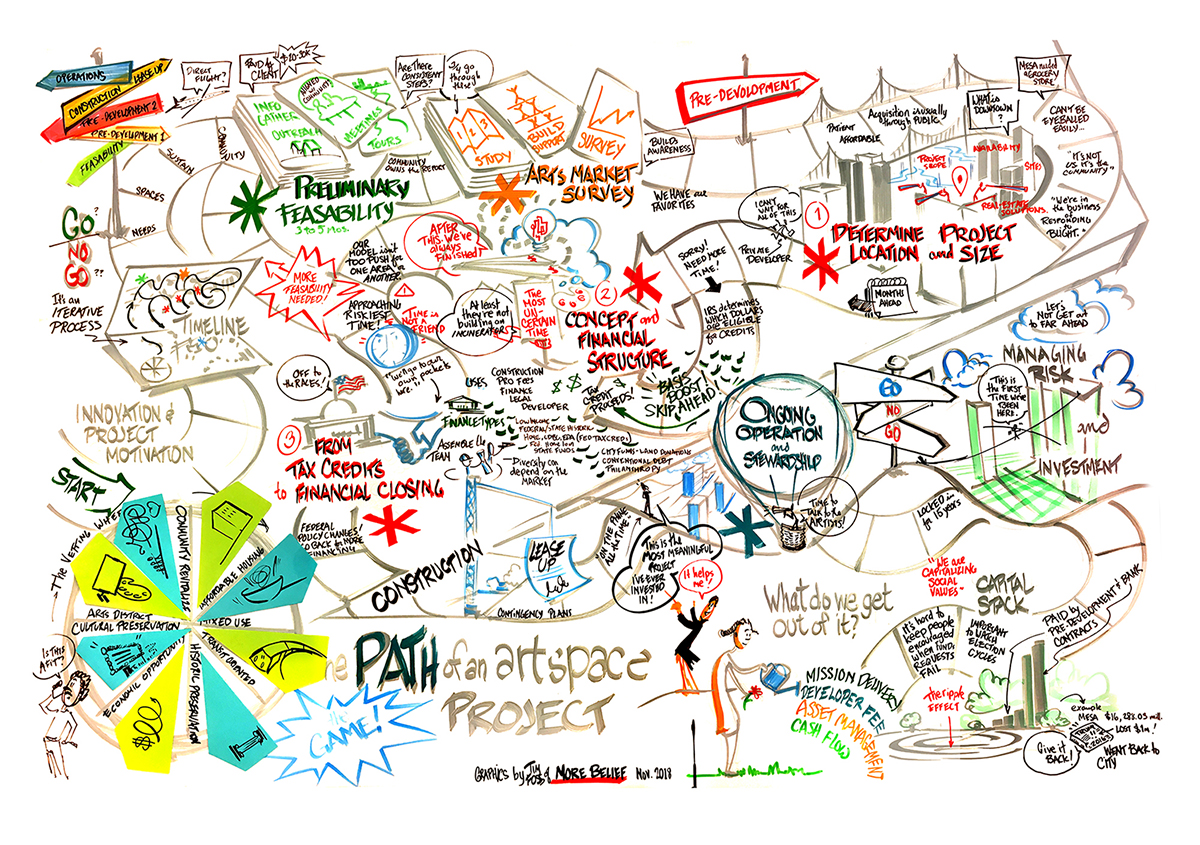By Dana Mattice, Artspace Article
Timothy Foss places Graphic Recording within the larger Visual Storytelling field, but defines it specifically as a visual story drawn live. Foss makes his livelihood this way: by listening, and then creating metaphors to make meaning out of what he hears, stating that “this connects us to ourselves and others.” Originally a potter, Foss sees Graphic Recording as a functional art like pottery—but a vessel that holds ideas.
Artspace staff worked with Foss and his colleague, Jake Rudegeair, to capture their presentation, “Pathway to an Artspace Project,” for the Artspace Board of Directors. Rudegeair had the initial conversation with the team to learn about the Artspace real estate development process that would be covered in the presentation, and then passed information on for Foss to conceptualize what it would look like drawn live. His metaphor to illustrate the Artspace process? A board game.
To begin his assignment, Foss first drafted a thumbnail (pictured upper left), and then scaled it up, arriving to the board room for the presentation equipped with a loose sketch of the Artspace Pathway Board Game drafted in gray (pictured upper right). This would be the basis for his work during the next hour. Then, he listened carefully to the presentation and filled in content, performing live, as the board heard the presentation and watched Foss capture concepts in image form. The detailed financial information was unexpected for Foss, and he visually improvised it within the middle of the artwork. Any questions or comments by the board of directors was added in black—literally, anything board members “spoke out loud” is caught on paper. The final illustration is shown below.


While created in a business setting, Foss stresses that this end product is still art. It is OK, he said, if the viewer doesn’t immediately know what they are seeing. It is healthy to experience it with permission to not initially understand, as one would with any other artwork. But, Foss can help us glean the significances across this art piece, and points out some key highlights:
- First, it is important to know that the drawing shows a gameboard, the “Game of Life,” and a pathway across. There is so much to look at, Foss understands that not everyone will immediately tune in to this aspect—but it is the key to comprehending the idea.
- Then, viewers should come to understand the motivation at bottom left—the spinning wheel—which shows how Artspace must pick a concept or angle for a real estate development project. It can vary depending on who the team is partnering with.
- He next brings attention to the deck of cards, which show feasibility studies, arts market surveys, and other items that the Artspace team may need to revisit, or “grab more cards,” in the predevelopment window. The deck of cards can be revisited even as late as the financing stage in the Pathway and is even why the game board doubles back at that point—just in case further research is needed. “Just like in life,” Foss says, “we sometimes have to swing back and gather more information before heading over the ledge.”
- A bridge moves the player from planning and predevelopment to the development stages of construction, lease-up, and an operating project.
- There is an edge, or a ledge, in the game with clouds underneath. On the upper level the path is conceptual; but once the Artspace player moves across the board game into finance and construction, s/he is “dropping off the ledge into on-the-ground reality, with real dirt being dug.”
Foss is happy to pull back the curtain and share his process from conception to product, and understands that there is still magic in it—even if viewers can see how he got there.
“There is something captivating about watching the blank page transform, and images emerge from the void,” said Kathleen Kvern, Senior Vice President of National Advancement, who booked Foss for the job.
“Tim’s presentation really made an impact with our board members, especially the visual thinkers. Seeing the concepts illustrated adds depth and texture to a person’s understanding of complex ideas and issues.”
Foss finds incredible meaning in his work as a visual practitioner. For many people, Foss says, art is stuck in an entertainment-commodity value—as décor on the wall. And even for artists who have gone through graduate school and think about things very conceptually, there are challenges in supporting themselves.
Foss believes he has found a sweet spot with Graphic Recording: A functional art that serves people where they need it in the workplace. He cites workplace stress as the third leading cause of death today, and truly believes that art saves lives. Bringing art into businesses, Foss hopes to move the needle on what we accept as healthy and engaging. He also hopes that he can help young artists realize that creating art, especially Graphic Recordings in a business setting, can truly be a service to others and their quest for meaning—“one of the most important things you can do.”
To learn more about Foss, or to book his Graphic Recording for your own event, please visit http://www.morebelief.com.

